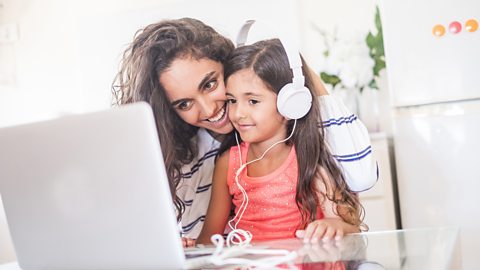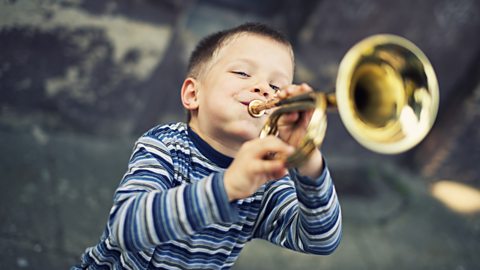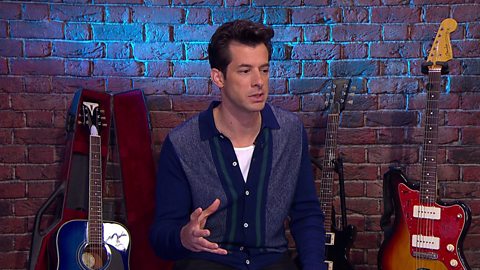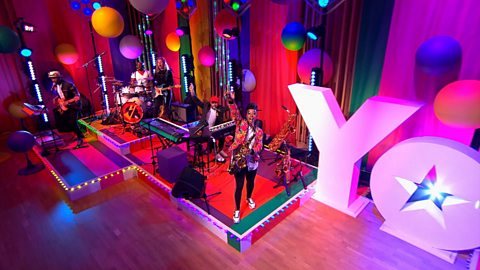Easy ways to get children singing and dancing at home

1. Encourage listening skills
Getting children to explore music and describe what they hear is a useful way to help them grow their listening skills.
Pick a piece of music to play and while listening to it ask children some simple questions about what they hear e.g.
• How could you describe this music?
• What sounds can you hear in this music?
• How does this music make you feel?
• What does this music make you think of?
Listening and describing in this way can really help a child's communication development.


2. Play along to music
All children love to make a noise and playing instruments along to a song is a great way of experiencing and exploring dynamics -the volume of sound of a piece of music.
Invite your child to play as quietly or loudly as they can with different sound makers or body percussion, e.g. how loudly can we clap our hands, how quietly can we tap a pan with a spoon?
Playing along is also a great way to discover the pulse of a song – essentially the heartbeat of the music, also referred to as a steady beat.
Typically the pulse is what people tap their foot to or dance along to when listening to music.
Using a sleeping puppet, invite your child to wake it up by playing loudly and when it goes to sleep to play quietly.
Using a pop-up puppet, you can gradually move the puppet up and down and ask your child to play gradually louder and gradually quieter.
This also works with an umbrella, gradually opening and closing it.


3. Explore the different instruments that make up a song
Try playing games and activities as a way of identifying how a variety of instruments combine to make a piece of music
Watch this performance by the 91»»±¨ Philharmonic orchestra of I am a Robot.
Different instruments in the orchestra have different roles in the music.
Listen out for the sounds of families of instruments and the role they have in the music.
Instrument families from the orchestra are:
• Brass – instruments such as trumpets, trombones, tuba
• Strings – instruments such as cello, violin, viola
• Percussion – instruments such as drum kit, cymbals, xylophone
• Woodwind – instruments such as flute, clarinet and saxophone
• Keyboard – instruments such as piano, keyboard, organ
The different instrument families taking part in I am a Robot can be spotted by the different colour shirts the musicians are wearing.
You can play games to explore this with children, whilst listening you could stand up when you hear a brass sound, parents could represent the brass section whilst the children could, for example, represent the string section and stand when the strings play.
This is a great way to encourage active listening.
To breakdown the different instruments used in songs and create your own sounds try the Play It! interactive music tool.


4. Make your own sounds
A great way of exploring music is to experiment with sounds that can be created with mouths.
Why not think about:
• What sounds can we make with our lips?
• What sounds can we make with our tongues?
• What sounds can we make with our teeth?
Try encouraging children to describe the sounds they make. By doing this you will be exploring different sounds and encouraging active listening.
Playing with mouth sounds is a physical exercise which supports children’s muscles in their mouths, which in turn helps their speech development.
Explore the kitchen – pots and pans are always useful to encourage the exploration of sounds e.g. tapping a pan with a spoon creates a different sound when you tap or ‘swish’ a pan with your hand.
Experiment with how many different sounds can be found by playing with kitchen utensils or things you can find outside, e.g. leaves and twigs.


5. Get moving to music
Tempo refers to the speed in music and a great way for children to explore this is physically.
Invite your child to move whilst listening to music and watch how they respond, then follow and copy their ideas.
Copying their physical ideas will show them you value their ideas.
Some children may find physically expressing their response to music much more natural than talking about or playing instruments with the music.
Try experimenting with a wide range of genres of music and watch how your child responds.
Experimenting with music with a range of tempo can be really good fun.
Zorba the Greek is a great example to try out as the tempo in the music gradually increases.
Listening to music from around the world, from a range of cultures will offer children rich listening experiences.

More from Bring the Noise
Mark Ronson's childhood inspiration
Mark Ronson was surrounded by music from an early age.

Sonic Explorers: Garden and rainforest. video
Sonic Explorer J discovers the sounds of the garden and jungle.

YolanDa's Band Jam
YolanDa and her Band Jammers with a collection of songs introducing some of the main elements of music making.
